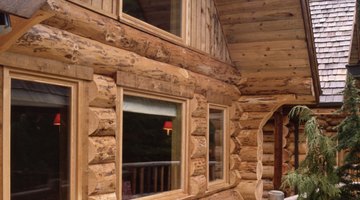Can You Whitewash Log Cabin Interior Walls?
If you have a true log cabin, you might want to preserve the rustic character of the interior of the log walls. You could leave them to darken naturally over time or apply a stain or clear finish to enhance the color and texture of the logs. Another option would be to whitewash the walls.

You'll need to understand the qualities of whitewash, however, before using it inside any home.
Description
Whitewash, also called calcimine or lime paint, is a low-cost paint made from lime and chalk. Thinned with water, it forms a thick, white coating that hardens as it reacts to carbon dioxide in the atmosphere. Whitewash is appreciated for more than its low cost. It forms a durable coating that breaths, allowing water vapor to exit a structure. The finish is chalky and rubs off when touched.
Uses
Famous for its use in Tom Sawyer's fence painting adventure, whitewash has been around for centuries. It's useful not only for fencing, but also for exterior wood and masonry surfaces. Because its chalky surface rubs off on clothing, it was not typically used inside when other finishes were available. In poor households, however, it was often the only affordable option for interior painting.
Paint
Flat latex paint is an alternative if the chalkiness of whitewash turns you off. Some homeowners thin the paint to create a nearly transparent quality. Latex paint that uses chalk to simulate the dry, chalky appearance of whitewash is often available at paint stores and from mail-order suppliers.
Alternatives
The interior logs of log houses are often left to darken naturally over time. Popular, too, is the use of a clear finish to impart a glossy or dull sheen to the timbers. A penetrating wood preservative prevents oxidation and preserves the color of new logs.
The Drip Cap
- If you have a true log cabin, you might want to preserve the rustic character of the interior of the log walls.
- Another option would be to whitewash the walls.
- You'll need to understand the qualities of whitewash, however, before using it inside any home.
- Because its chalky surface rubs off on clothing, it was not typically used inside when other finishes were available.
Writer Bio
Robert Lewis has been writing do-it-yourself and garden-related articles since 2000. He holds a B.A. in history from the University of Maryland and has training experience in finance, garden center retailing and teaching English as a second language. Lewis is an antiques dealer specializing in Chinese and Japanese export porcelain.
Photo Credits
- Ablestock.com/AbleStock.com/Getty Images
- Ablestock.com/AbleStock.com/Getty Images
More Articles



